Review from last class:
Regulation of Synaptic Transmission:
The body will react to biochemical pathways (i.e. acetylcholine/dopamine) being consistently stimulated by downregulating receptors. Too much signaling = too much processing = body wants to slow these signals to manageable and useful rate. Likewise, if the signals are not happening frequently, the bottom will upregulate the receptors to make the neurons more sensitive to signals and thus more likely to fire.
Upregulation: Cellular increase in the number of receptors to a molecule, such as a hormone or neurotransmitter, which reduces the cell’s sensitivity to the molecule.
Ex. If not enough Substance P is being released, the body is not receiving signals to process pain at a consistent rate. More receptors make it easier to trigger an action potential in the post-synaptic neuron.
Downregulation: Cellular decrease in the number of receptors to a molecule, such as a hormone or neurotransmitter, which reduces the cell’s sensitivity to the molecule.
Ex. If too much dopamine is released consistently, the neurons are firing too often. Body will downregulate the receptors thus it is harder to trigger an action potential in the post-synaptic neuron.
Examples given out in class: Nicotine on acetylcholine – nicotine is a receptor antagonist. This means it acts just like acetylcholine and can bind to the same postsynaptic receptors. Leads to downregulation of postsynaptic receptors.
Opioids on dopamine – leads to downregulation of dopamine receptors on post synaptic neuron.
Opioids and pain – blocks substance P release, no signals sent to nociceptors, no pain. Nociceptors upregulated to become more sensitive.
Peripheral Nervous System:
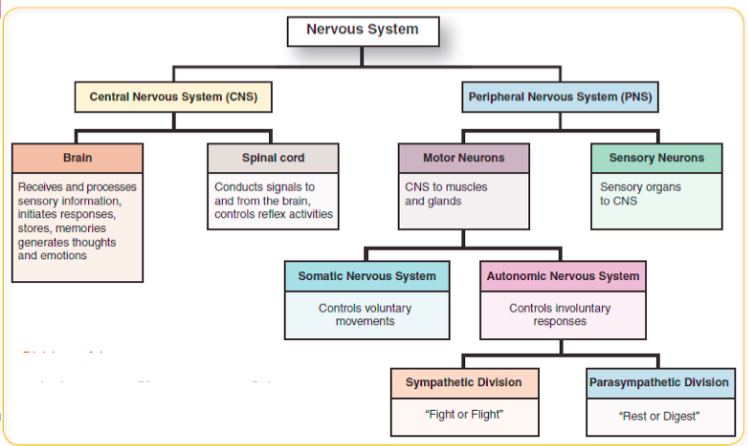
PNS = all nerves/neurons outside of the CNS.
- Sensory neurons – Dendrites are activated by stimuli and send their signal along the axon which extends into the CNS.
- Motor neurons – The dendrites are found within the CNS and receive impulses and transmit these signals along their axon outside the CNS to an effector.

Peripheral Nervous System is divided into two roles:
- Somatic Nervous System – Voluntary Movement. Communicates with sense organs and muscles.
- Autonomic Nervous System – Involuntary Actions. Communicates with organs and glands.
- Sympathetic Nervous System: Active functions “Fight or Flight:
- Parasympathetic Nervous System:Vegetative functions “Feed and Breed”
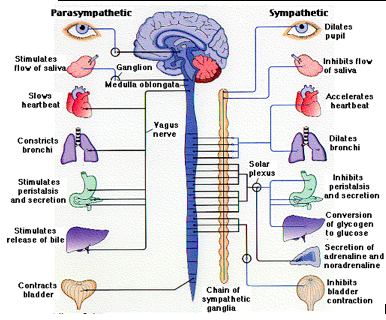
Together these maintain homeostasis!
The parasympathetic/sympathetic nervous systems are antagonistic – they work on the same areas with opposite effects.
Ex. Excitatory Neurotransmitter = noradrenaline (norepinephrine). Destroyed in the synapse by enzyme monoamine oxidase.
Antagonistic Neurotransmitter = Acetylcholine. Destroyed in the synapse by enzyme acetylcholinesterase.
These neurotransmitters can bind to the same receptors but lead to different excitatory or inhibitory effects!
Sympathetic releases norepinephrine = increased heart rate, decreased digestive activity
Parasympathetic releases acetylcholine = decreases heart rate increases digestive activity
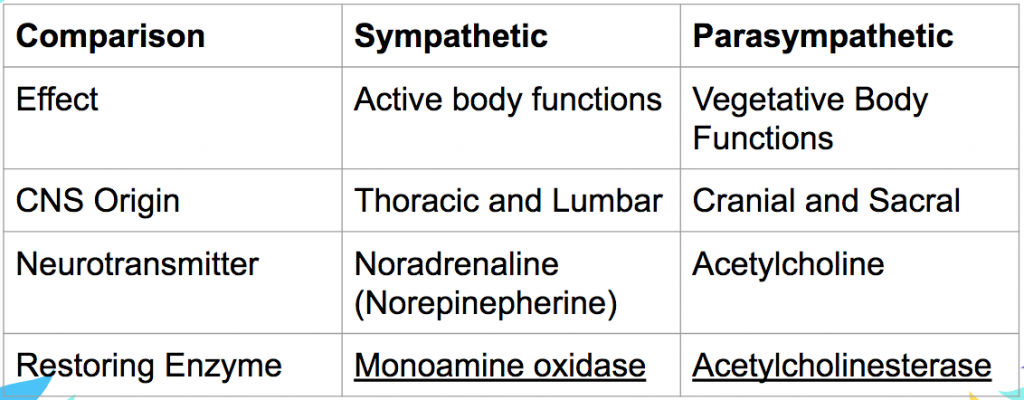
Fight or Flight Response:
- Sudden Release of noradrenaline from sympathetic neurons in times of fright.
- This stress is process by the CNS as well, which stimulate adrenaline release from the adrenal glands on the top of the kidneys.

- These are very similar and together they have related, profound effects:
- Increased heart rate – more blood to body quickly.
- Blood flow altered – contraction of surface tissue arterioles (going pale) and digestive system. More to skeletal muscles.
- Widening of airways – More gas exchange with each breath
- Contraction of skeletal muscles – tensing up, ready for action (includes diaphragm (“gasping” when scared)
- Contraction of iris – wide pupil, more visual alertness
- Glycogen -> glucose for ATP production promoted
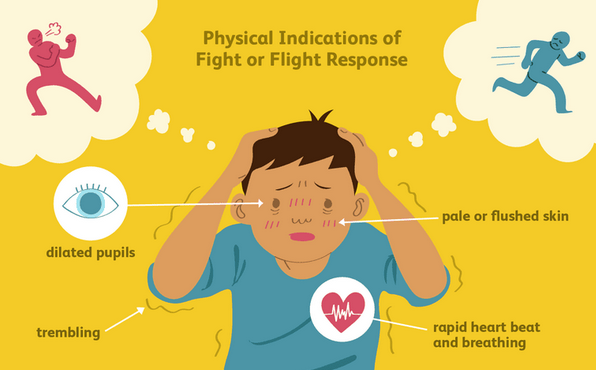
Neuroendocrine Control
Endocrine system – a chemical messenger system consisting of hormones, the group of glands that secrete those hormones directly into the circulatory system to regulate the function of distant target organs. Helps maintain homeostasis.
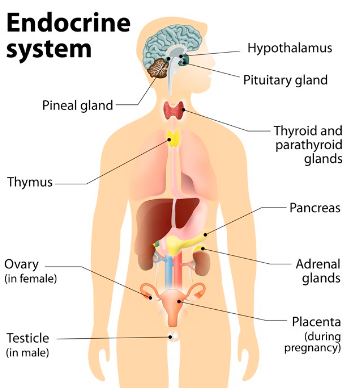
Certain responses of the body are regulated by hypothalamus and pituitary gland.
- Blood passes through hypothalamus where it is assessed (composition, temp)
- Homeostatic responses stimulated!
- This is neuroendocrine control.
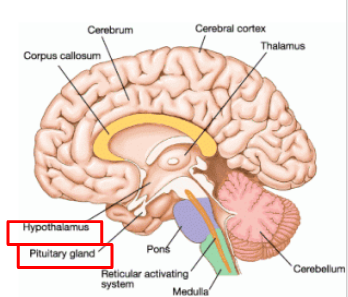
Anterior Pituitary Gland – Releases hormones related to skeletal growth/reproduction
Posterior Pituitary Gland – Releases ADH (plays role in urinary system) and oxytocin (reproductive system)
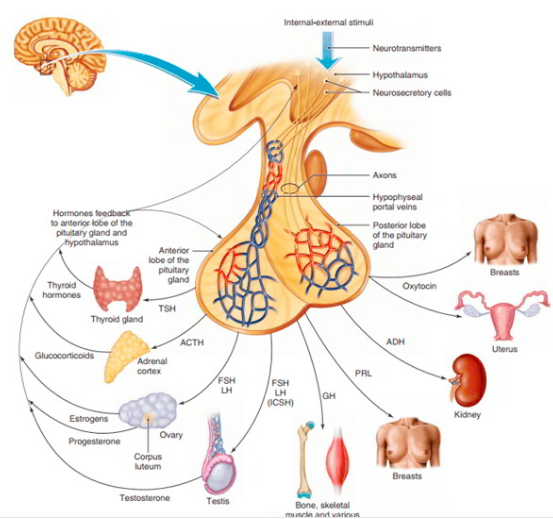
Review and Practice for May 14th test:
- “Impulse: Designing a step-by-step diagram (This should take the place of written questions as you will be spending lots of time organizing information regarding voltage, ions, channels, etc.)
- 22 Provincial Multiple Choice questions – Practice these! Answers listed on bottom. (Remember: there are only so many MC questions per unit! The more you see, the better your odds of getting similar/identical questions on your unit test and final!)
- Additional Questions broken down by section:
Part 1: The CNS
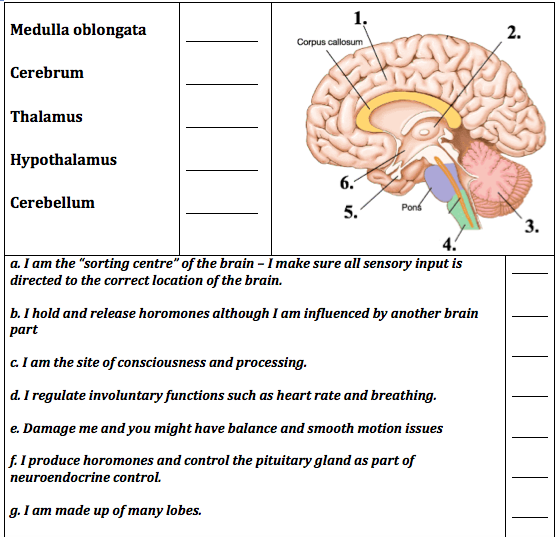
Part 2: Neurons
- What is a myelin sheath? What are the benefits of myelination?
- What is the difference between dendrites and axons? How are motor neurons and sensory neurons different in terms of structure and function?
Part 3: Transmission
Complete your “Impulse: Designing a step-by-step diagram.” This should take the place of written questions as you will be spending lots of time organizing information regarding voltage, ions, channels, etc. I have included questions below if you want additional review practice.
- Look at the graph of an action potential. Please label and describe what is happening at each stage.
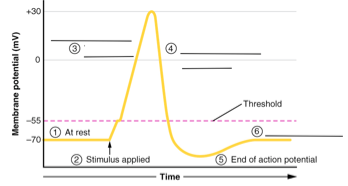
- Which parts of an axomembrane maintain their levels of Na+ and K+ even during an action potential? Which areas change their levels of Na+ and K+ during an action potential?
- While at a party, an unnamed person tried cocaine. The person liked the feeling of euphoria due to the release of dopamine and the inhibition of its reuptake. This person continued to use cocaine regularly for the next month, however the person is noticing they need more and more to get a similar effect. Describe what is happening in the synaptic gap that can explain this tolerance.
- Define upregulation. Give an example of when we could see this in an individual.
- Define downregulation. Give an example of when we could see this in an individual.
- Explain how we can perceive different intensities of sensation, even though neurons have an “all or nothing” approach to sending a signal.
Part 4: PNS/Endocrine Control
- Define: autonomic nerves and somatic nerves.
- Describe what is meant when we say the two branches of the autonomic nervous system being “antagonistic.” Support this with an example.
- What two substances are released during a “fight or flight” response. What releases these substances? What are some changes these cause in our body?
Comments by shaun pletsch